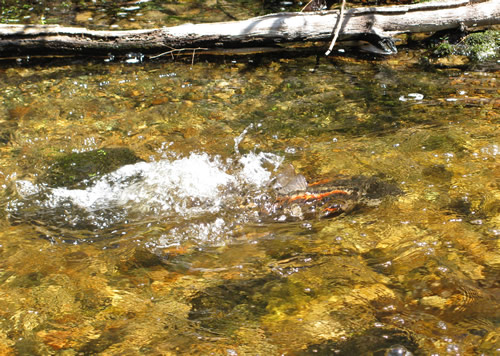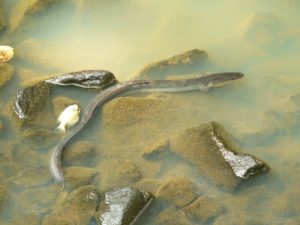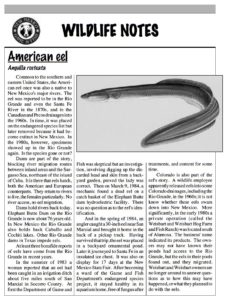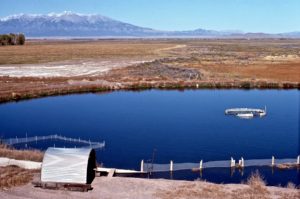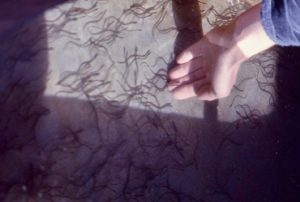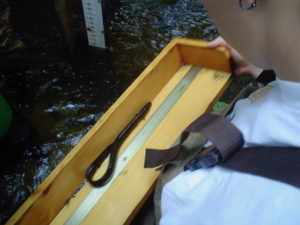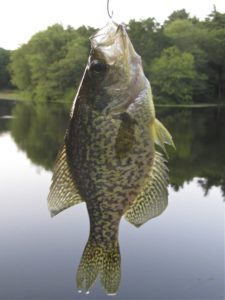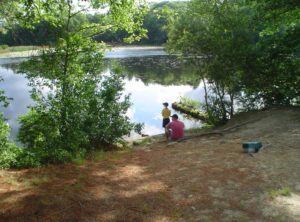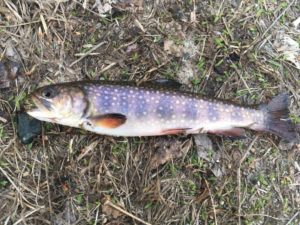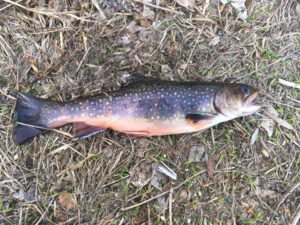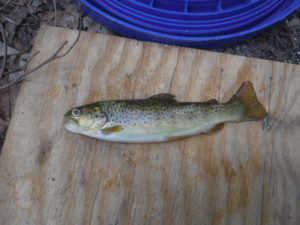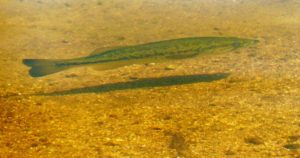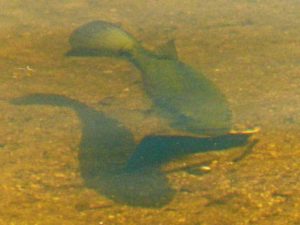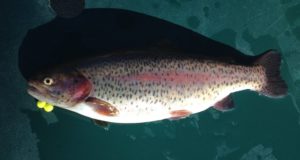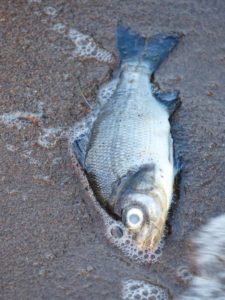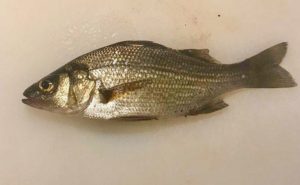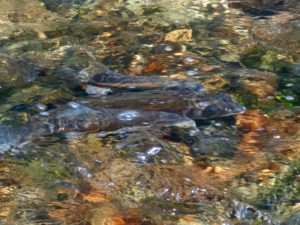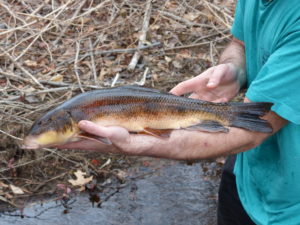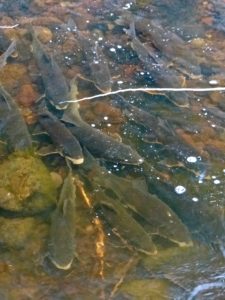Sightings – Fish
Observer: Paul Lauenstein
Observation Date: 7/21/14
Observation Time: 10:15 a.m.
Observation Location: Billings Brook below the Gavins Pond Dam
Common Name: American eel
Scientific Name: Anguilla rostrata
Comments: American eels spawn in the Sargasso Sea in the Atlantic Ocean. The larval eels, called glass eels because they are transparent, drift with the Gulf Stream up the east coast. They eventually metmorphose into worm-sized black elvers, which swim up coastal rivers all along the east coast. This eel came into Narragansett Bay and swam up the Taunton River and then up Billings Brook to Sharon. Eels mature for several years in fresh water. When they reach three or four feet in length, they turn into silver eels and migrate all the way back to the Sargasso Sea, where they spawn and die.
Note the dead sunfish in the photo. Pumping of Well #5 and Well #7 along Billings Brook upstream of Gavins Pond to provide water for lawn irrigation reduced flow in Billings Brook so much that water stopped spilling out of Gavins Pond. With no flow, the water in the pool below the dam stagnated so there was not enough dissolved oxygen for fish to survive.
More Information: Wikipedia
Following is the story of how eels were blocked by dams from swimming up rivers such as the Rio Grande, but mysteriously reappeared in the Rio Grande in the early 1980s.
I was the one who put them there. I was the manager of a fish farm in Alamosa, CO from 1977 to 1980. We decided to try to grow eels and export them to Japan where they are considered a delicacy. I flew to North Carolina where I caught a bunch of elvers and brought them back to the fish farm in Alamosa. We tried to grow them but they escaped to the nearby Rio Grande.
Weisbart’s fish farm in Alamosa, Colorado
elvers imported to Alamosa from North Carolina in 1979
Observer: Paul Lauenstein
Observation Date: 8/25/08
Observation Time: 10:00 a.m.
Observation Location: Beaver Brook near the outbound train station
Common Name: American eel
Scientific Name: Anguilla rostrata
Comments: American eels spawn in the Sargasso Sea in the Atlantic Ocean. The larval eels, called glass eels because they are transparent, drift with the Gulf Stream up the east coast. They eventually metmorphose into worm-sized black elvers, which swim up coastal rivers all along the east coast. This eel came into Boston Harbor and swam up the Neponset River and then up Beaver Brook to Sharon. Eels mature for several years in fresh water. When they reach three or four feet in length, they turn into silver eels and migrate back to the Sargasso Sea, where they spawn and die.
More Information: Wikipedia
Observer: Paul Lauenstein
Observation Date: 8/5/11
Observation Time: 6:40 p.m.
Observation Location: Gavins Pond
Common Name: Black Crappie (Calico Bass)
Scientific Name: Pomoxis nigromaculatus
Comments: Crappies are a popular sport fish, as they are easy to catch when they are feeding. As with other freshwater species in Massachusetts, crappies accumulate mercury in their tissues as a result of environmental pollution from power plants.
More Information: All About Fishing
Observer: Paul Lauenstein
Observation Date: 6/4/10
Observation Time: 11:45 a.m.
Observation Location: Gavins Pond
Common Name: Bluegill Sunfish
Scientific Name: Lepomis macrochirus
Comments: These sunfish were spawning on a sandy area near the shore.
More Information: Southshore Fishing
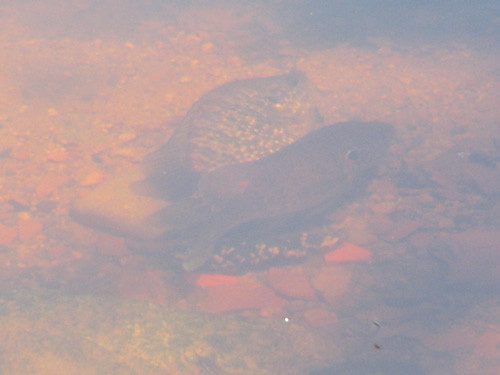
Observer: Paul Lauenstein
Observation Date: 6/4/10
Observation Time: 11:30 a.m.
Observation Location: Borderland State Park
Common Name: Bluegill Sunfish
Scientific Name: Lepomis macrochirus
Comments: This bluegill sunfish was guarding its eggs.
More Information: Wikipedia
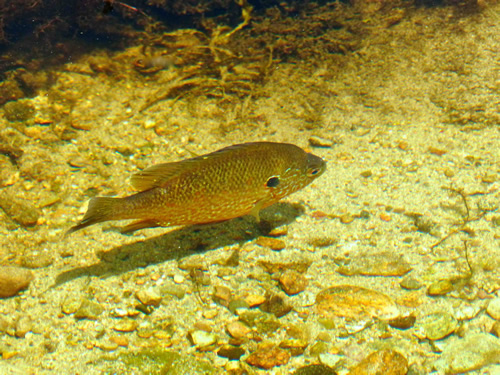
Observer: Steven D’Addieco
Observation Date: 4/19/20
Observation Time: 7:15 p.m.
Observation Location: undisclosed location in Sharon
Common Name: Brook trout
Scientific Name: Salveninus Fontinalus
Comments: Pollution and dams have greatly reduced native brook trout populations in eastern Massachusetts. Brook trout are vulnerable to global warming because they cannot survive in warm water.
Please practice catch and release to help conserve these beautiful fish.
More Information: Massachusetts Wildlife
Observer: Steven D’Addieco
Observation Date: 6/6/15
Observation Time: N/A
Observation Location: Massapoag Brook
Common Name: Brown trout
Scientific Name: Salmo trutta
Comments: I caught and released this small brown trout in the late spring of 2015. Please practice catch and release to help conserve these beautiful fish.
More Information: Wikipedia
Observer: Paul Lauenstein
Observation Date: 8/27/10
Observation Time: 3:45 p.m.
Observation Location: Beaver Brook near tennis courts
Common Name: Bullhead Catfish
Scientific Name: Ameiurus melas
Comments: I noticed a number of small black fish swimming near the dam, so I got a dipnet and caught this one (don’t worry, I released it alive!). It turned out to be a bullhead catfish. When the Department of Fish and Game sampled the fish in Beaver Brook on August 25, 2008 with electro-shocking equipment (which stuns fish but does not kill them) they found redfin pickerel, sunfish, bass and American eels, but they did not find bullhead catfish.
More Information: Wikipedia
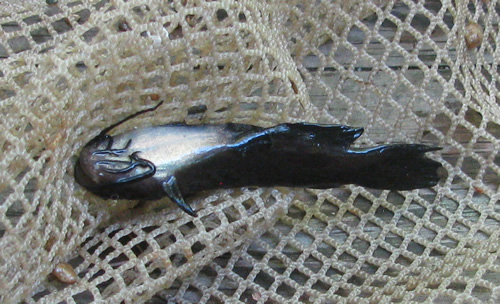
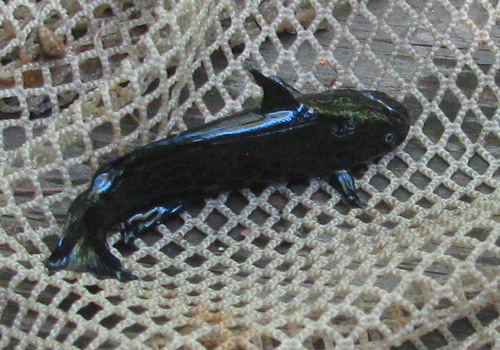
Observer: Paul Lauenstein
Observation Date: 7/11/15
Observation Time: 2:00 p.m.
Observation Location: Lake Massapoag
Common Name: Largemouth bass
Scientific Name: Micropterus salmoides
Comments: There are some big largemouth bass in Lake Massapoag, which also supports a population of smallmouth bass. Largemouth bass are also present in smaller ponds in Sharon but smallmouth bass require cool, clear water so they are found only in the spring-fed waters of Lake Massapoag.
More Information: American Expedition
Observer: Steven D’Addieco
Observation Date: 3/8/17
Observation Time: noon
Observation Location: Lake Massapoag
Common Name: Rainbow trout
Scientific Name: Oncorhynchus mykiss
Comments: I remember casting out into the shallow water until suddenly when I was reeling my line in I realized I had a fish on the line and reeled it in.
It turns out that I accidentally snagged this Rainbow Trout.
More Information: Trout Stocking Report
Observer: Paul Lauenstein
Observation Date: 8/11/10
Observation Time: 8:00 a.m.
Observation Location: Gavins Pond outflow pool
Common Name: Redfin Pickerel
Scientific Name: Esox americanus americanus
Comments: Redfin pickerel only reach a maximum of about a foot in length. They are typically much smaller—this specimen was only about 4″ long. They are common in Sharon’s streams. Preys on invertibrates and smaller fish.
More Information: Wikipedia
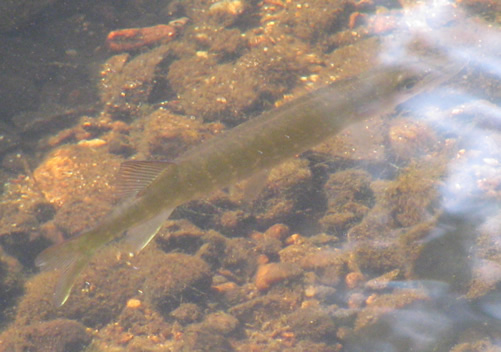
Observer: Paul Lauenstein
Observation Date: 6/10/15
Observation Time: 7:30 p.m.
Observation Location: Lake Massapoag
Common Name: White Perch
Scientific Name: Morone Americana
Comments: There are lots of white perch in Lake Massapoag. This one died and washed up on the shore.
More Information: MA Fish Finder
Observer: Steven D’Addieco
Observation Date: 8/15/21
Observation Time: 8:30 p.m.
Observation Location: Lake Massapoag
Common Name: White Perch
Scientific Name: Morone Americana
Comments: There are lots of white perch in Lake Massapoag. White perch are good to eat. White perch are not a true perch but, rather, belong to the bass family, Moronidae.
More Information: Wikipedia
Observer: Steven D’Addieco
Observation Date: 8/23/19
Observation Time: 6:00 p.m.
Observation Location: Lake Massapoag
Common Name: White Perch
Scientific Name: Morone Americana
Comments: There are lots of white perch in Lake Massapoag. White perch are good to eat. White perch are not a true perch but, rather, belong to the bass family, Moronidae.
More Information: Wikipedia
Observer: Paul Lauenstein
Observation Date: 4/17/13
Observation Time: 12:40
Observation Location: Beaver Brook, Sharon (downstream of the wooden footbridge near the tennis courts at the outbound train station)
Common Name: White Sucker
Scientific Name: Catostomus commersoni
Comments: White suckers spawn in Beaver Brook for a few days in mid to late April. Remember to look for them after you file your taxes. Note the reddish stripes on the sides of the males flanking the female in the photo. The female and the males release their eggs and sperm simultaneously, thrashing their tails to mix them and ensure fertilization. White suckers also spawn in Sucker Brook where it enters Lake Massapoag near the entrance to the Community Center.
Check out this 2-minute video of white suckers spawning in Beaver Brook: https://www.youtube.com/watch?v=ru_KsfE4ZJQ
Observer: Richard Kramer
Observation Date: 4/19/13
Observation Time: 2:35 p.m.
Observation Location: Sucker Brook near the entrance to the Community Center
Common Name: White Sucker
Scientific Name: Catostomus commersoni
Comments: White suckers spawn in Sucker Brook for a few days in mid to late April. Remember to look for them after you file your taxes. The female and the males release their eggs and sperm simultaneously, thrashing their tails to mix them and ensure fertilization. White suckers also spawn in Beaver Brook just downstream of the wooden footbridge near the tennis courts at the outbound train station.
Check out this 2-minute video of white suckers spawning in Beaver Brook: https://www.youtube.com/watch?v=ru_KsfE4ZJQ
More Information: Massachusetts Wildlife
Observer: Paul Lauenstein
Observation Date: 4/25/09
Observation time: 1:05 p.m.
Observation Location: Beaver Brook, Sharon (downstream of the wooden foot bridge near the tennis courts)
Common Name: White Sucker
Scientific Name: Catostomus commersoni
Comments: White suckers in spawning frenzy in Beaver Brook, 4/25/09. Note the red stripes and erect dorsal fins. Suckers typically spawn for a few days sometime between April 15 and April 30. They also spawn in Sucker Brook where it enters Lake Massapoag near the entrance to the Community Center.
2-minute video of white suckers spawning in Beaver Brook: https://www.youtube.com/watch?v=ru_KsfE4ZJQ
